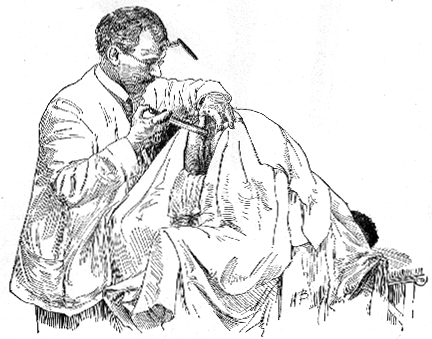

Max Brödel, of the Johns Hopkins Hospital and Medical School, was the founder of modern medical illustration. A German by birth, a Hopkins professor lured him as a young man in 1894 to that new hospital and medical school in Baltimore, Maryland, U.S.A.; by the early twentieth century, he was the first professor of art as applied to medicine in the first department of that specialty in the world, created because Dr. William J. Mayo of the new Mayo Clinic was tempting him with a fat job, and Hopkins wanted to keep him. The donor of the money used to create the new department was Henry Walters (interestingly, medical courses he took at Harvard made him sick), a wealthy Baltimorean, whose eponymous Baltimore gallery showed a selection of Brödel's work in April 1997. Here are two of his probably thousands of drawings and paintings; see also his pessary elswhere. The drawing right below is "Muscles of the Pelvic Floor in Relation to Rectal and Vaginal Openings" from the 1928 edition of Howard Kelly's Gynecology. Dr. Kelly was the first professor of gynecology at Johns Hopkins. |


As an artist myself, I think Brödel's pen-and-ink drawings are his best, requiring real thought in selection of lines. This drawing is "Method of Introducing Long Rectal Speculum to Examine Entire Length of Lower Bowel," from the same volume as above (speaking of rectums, see here). The doctor looks a lot like Dr. Kelly, and probably is. Dr. Kelly is one of the four Hopkins doctors in the famous painting by John Singer Sargent; much in modern medical practice started with them and Johns Hopkins.By the way, the "woman" in the awkward position in this drawing is undoubtedly none other than the good-humored Dr. Thomas Cullen, second professor of gynecology at Johns Hopkins! Because of mores, Brödel had trouble finding living female models, although he had plenty of autopsy specimens to draw from. According to Ranice W. Crosby and John Cody, authors of Max Brödel, The Man Who Put Art Into Medicine (Springer-Verlag, 1991), Cullen volunteered to pose nude, and the artist added something here and took away something there to create a woman. Cullen later liked to show people the drawing and ask them who they thought the model was; he loved telling them the answer!The"woman" on the table is black, and blacks sometimes appear in illustrations in this standard text, maybe because it was more "decent" than showing a white woman. The text calls them Negresses. Modern gynecology is often said to start with the work of Dr. Marion Sims in the middle of the last century. He's best remembered for developing a successful operation for repairing severe injuries caused by childbirth, and he developed the operation using American slaves. |